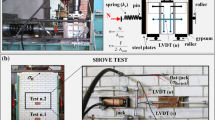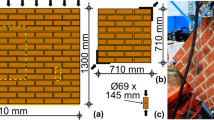Abstract
Aiming towards a better understanding of the structural response presented by multi-perforated clay brick masonry, this paper presents the results of an experimental program focused on characterizing the behavior of its constituent materials and interfaces, and on providing numerical strategies to appropriately reproduce that behavior. Different displacement controlled test set-ups were carried out in the laboratory for this purpose, giving special attention to characterizing the shear response at horizontal unit-mortar interface in order to point out the influence that mortar spikes penetrating into the perforated bricks cavities can exert. According to its detailed consideration of materials and interfaces, the detailed micro-modeling numerical approach was selected for this study. The numerical strategies proposed have led to a satisfactory reproduction of the shear triplet tests and diagonal compression tests that were performed, showing that the complex structural response of multi-perforated clay brick masonry can be appropriately reproduced from experimental evidence.













Similar content being viewed by others
References
Zepeda JA, Alcocer SM, Flores LE (2000) Earthquake-resistant construction with multi-perforated clay brick walls. In: 12th world conference on earthquake engineering, pp 1541–1548
Guillen I, Uris A, Estelles H, Llinares J, Llopis A (2008) On the sound insulation of masonry wall façades. Build Environ 43(4):523–529
del Coz JJ, Nieto PG, Sierra JS, Sánchez IP (2008) Non-linear thermal optimization and design improvement of a new internal light concrete multi-holed brick walls by FEM. Appl Therm Eng 28(8):1090–1100
Gabor A, Ferrier E, Jacquelin E, Hamelin P (2006) Analysis and modelling of the in-plane shear behaviour of hollow brick masonry panels. Constr Build Mater 20(5):308–321
Abdou L, Saada RA, Meftah F, Mebarki A (2006) Experimental investigations of the joint-mortar behaviour. Mech Res Commun 33(3):370–384
da Porto F, Guidi G, Garbin E, Modena C (2010) In-plane behavior of clay masonry walls: experimental testing and finite-element modeling. J Struct Eng 136(11):1379–1392
Fouchal F, Lebon F, Titeux I (2009) Contribution to the modelling of interfaces in masonry construction. Constr Build Mater 23(6):2428–2441
Pelissou C, Lebon F (2009) Asymptotic modeling of quasi-brittle interfaces. Comput Struct 87(19):1216–1223
Rahman A, Ueda T (2014) Experimental investigation and numerical modeling of peak shear stress of brick masonry mortar joint under compression. J Mater Civ Eng 26(9):04014061
Mojsilović N, Kostić N, Schwartz J (2013) Modelling of the behaviour of seismically strengthened masonry walls subjected to cyclic in-plane shear. Eng Struct 56:1117–1129
Lotfi H, Shing P (1991) An appraisal of smeared crack models for masonry shear wall analysis. Comput Struct 41(3):413–425
Milani G (2011) Simple homogenization model for the non-linear analysis of in-plane loaded masonry walls. Comput Struct 89(17):1586–1601
Drougkas A, Roca P, Molins C (2015) Numerical prediction of the behavior, strength and elasticity of masonry in compression. Eng Struct 90:15–28
Haach VG, Vasconcelos G, Lourenço PB (2011) Parametrical study of masonry walls subjected to in-plane loading through numerical modeling. Eng Struct 33(4):1377–1389
Lourenco PB (1996) Computational strategies for masonry structures. PhD Thesis, TU Delft, Delft University of Technology
Sousa R, Sousa H, Guedes J (2013) Diagonal compressive strength of masonry samples—experimental and numerical approach. Mater Struct 46(5):765–786
Bernat E, Ll Gil, Roca P, Sandoval C (2013) Experimental and numerical analysis of bending–buckling mixed failure of brickwork walls. Constr Build Mater 43:1–13
Sandoval C, Roca P, Bernat E, Ll Gil (2011) Testing and numerical modelling of buckling failure of masonry walls. Constr Build Mater 25(12):4394–4402
Sandoval C, Roca P (2012) Study of the influence of different parameters on the buckling behaviour of masonry walls. Constr Build Mater 35:888–899
Bolhassani M, Hamid AA, Lau AC, Moon F (2015) Simplified micro modeling of partially grouted masonry assemblages. Constr Build Mater 83:159–173
Bolhassani M, Hamid AA, Moon FL (2016) Enhancement of lateral in-plane capacity of partially grouted concrete masonry shear walls. Eng Struct 108:59–76
Gambarotta L, Lagomarsino S (1997) Damage models for the seismic response of brick masonry shear walls. Part I: the mortar joint model and its applications. Earthq Eng Struct Dyn 26(4):423–439
Sacco E, Lebon F (2012) A damage–friction interface model derived from micromechanical approach. Int J Solids Struct 49(26):3666–3680
Astroza M, Moroni MO, Brzev S, Tunner J (2012) Seismic performance of engineered masonry buildings in the 2010 Maule earthquake. Earthq Spectra 28(S1):S385–S406
Valdebenito G, Alvarado D, Sandoval C, Aguilar V (2015) Terremoto de Iquique Mw 8.2–01 Abril 2014: daños observados y efectos de sitio en estructuras de albañilería. In: XI Congreso Chileno de Sismología e Ingeniería Sísmica. 18–20 March, Santiago, Chile
Salmanpour AH, Mojsilović N, Schwartz J (2015) Displacement capacity of contemporary unreinforced masonry walls: an experimental study. Eng Struct 89:1–16
Tomazevic M, Weiss P (2012) Robustness as a criterion for use of hollow clay masonry units in seismic zones: an attempt to propose the measure. Mater Struct 45(4):541–559
Tomazevic M (2009) Shear resistance of masonry walls and Eurocode 6: shear versus tensile strength of masonry. Mater Struct 42(7):889–907
van der Pluijm R (1997) Non-linear behaviour of masonry under tension. Heron 42(1):25–54
Alcaino P (2007) Respuesta sísmica de muros de albañilería reforzados externamente con fibras de carbono: análisis experimental. MSc Thesis, School of Engineering, Pontificia Universidad Católica de Chile
INN (2001) Instituto Nacional de Normalización. Norma Chilena Oficial NCh167.Of2001. Construcción—Ladrillos cerámicos—Ensayos, Santiago
Lourenço PB, Vasconcelos G, Medeiros P, Gouveia J (2010) Vertically perforated clay brick masonry for loadbearing and non-loadbearing masonry walls. Constr Build Mater 24(11):2317–2330
CEB (1990) Model code 1990: design code. Thomas Telford, Lausanne
INN (1999) Instituto Nacional de Normalización. Norma Oficial Chilena NCh158.Of67. Cementos—Ensayo de flexión y compresión de morteros de cemento, Santiago, Chile
INN (1977). Instituto Nacional de Normalización. Norma Chilena Oficial NCh 1037.Of.77. Hormigón—Ensayo de compresión de probetas cúbicas y cilíndricas, Santiago
Almeida JC, Lourenço PB, Barros JA (2002) Characterization of brick and brick–mortar interface under uniaxial tension. In: Proceedings of 7th international seminar on structural masonry, Brazil: CEFET-MG, No. 1997, pp 67–76
CUR (1997) Structural masonry: an experimental/numerical basis for practical design rules. Report 171. In: Rots JG (ed) Balkema, Rotterdam
Haach V (2009) Development of a design method for reinforced masonry subjected to in-plane loading based on experimental and numerical analysis. PhD Thesis, University of Minho
Zimmermann T, Strauss A, Bergmeister K (2012) Structural behavior of low-and normal-strength interface mortar of masonry. Mater Struct 45(6):829–839
van der Pluijm R (1993) Shear behaviour of bed joints. In: Proceedings of the sixth North American Masonry conference, Philadelphia, 6–9 June, pp 125–136
INN (1993) Instituto Nacional de Normalización. Norma Chilena Oficial NCh 1928-Ofc. 93. Modificada, 2009 Albañilería Armada, disposiciones para el diseño y cálculo, Santiago
INN (2003) Instituto Nacional de Normalización. Norma Chilena Oficial NCh2123.Of97. Modificada, 2003 Albañilería Confinada, Requisitos de diseño y cálculo, Santiago
TNO Diana (2014) DIANA finite element analysis. TNO Diana, Delft
Lourenço PB, Almeida JC, Barros JA (2005) Experimental investigation of bricks under uniaxial tensile testing. Br Mason Soc 18(1):11–20
Chaimoon K, Attard MM (2007) Modeling of unreinforced masonry walls under shear and compression. Eng Struct 29(9):2056–2068
Arnau O, Sandoval C, Murià-Vila D (2015) Determination and validation of input parameters for detailed micro-modelling of partially grouted reinforced masonry walls. In: 10th Pacific conference on earthquake engineering, 6–8 November, Sydney
Acknowledgments
This research has been funded by the Chilean Fondo Nacional de Ciencia y Tecnología, (Fondecyt de Iniciación) through Grant No 11121161. The authors would like to thank the technician Camilo Guzmán and undergraduate student Carlos González for the support during the tests. The second author also wants to acknowledge the resources provided by the Institute of Engineering of UNAM through the Emilio Rosenblueth fellowship.
Author information
Authors and Affiliations
Corresponding author
Rights and permissions
About this article
Cite this article
Sandoval, C., Arnau, O. Experimental characterization and detailed micro-modeling of multi-perforated clay brick masonry structural response. Mater Struct 50, 34 (2017). https://doi.org/10.1617/s11527-016-0888-3
Received:
Accepted:
Published:
DOI: https://doi.org/10.1617/s11527-016-0888-3




